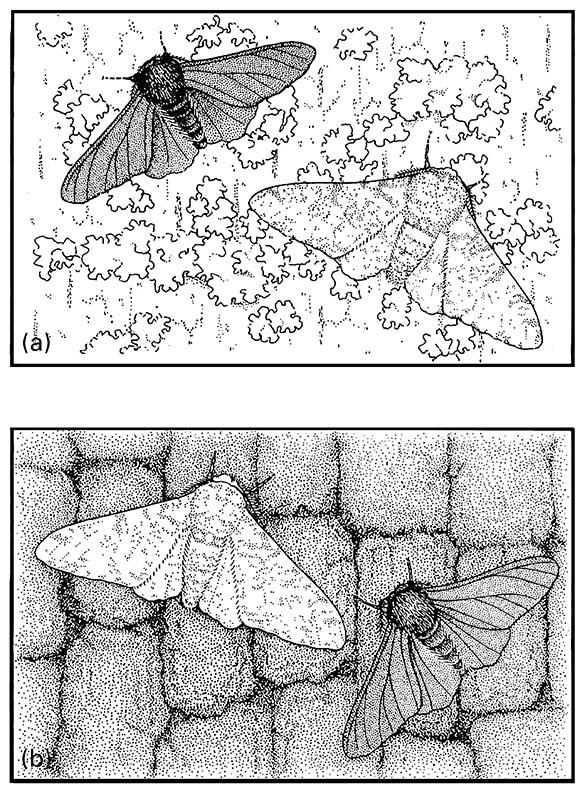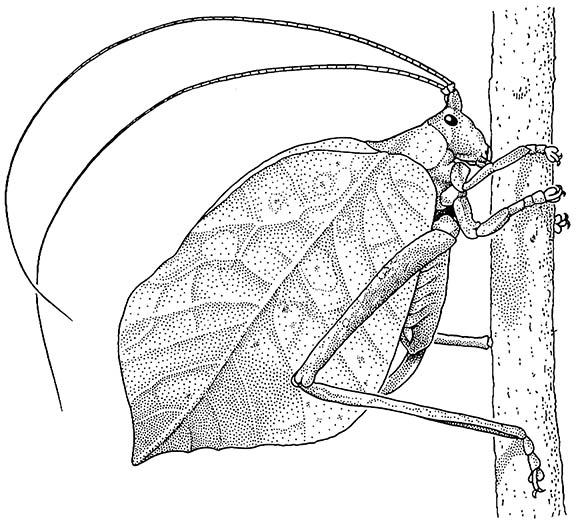14.1. Defense by hiding
Visual deception may reduce the probability of being found by a natural enemy. A well-concealed cryptic insect that either resembles its general background or an inedible (neutral) object may be said to “mimic” its surroundings. In this book, mimicry (in which an animal resembles another animal that is recognizable by natural enemies) is treated separately (section 14.5). However, crypsis and mimicry can be seen as similar in that both arise when an organism gains in fitness through developing a resemblance (to a neutral or animate object) evolved under selection. In all cases, it is assumed that such defensive adaptive resemblance is under selection by predators or parasitoids, but, although maintenance of selection for accuracy of resemblance has been demonstrated for some insects, the origin can only be surmised.
Insect crypsis can take many forms. The insect may adopt camouflage, making it difficult to distinguish from the general background in which it lives, by:
- resembling a uniform colored background, such as a green geometrid moth on a leaf;
- resembling a patterned background, such as a mottled moth on tree bark (Fig. 14.2; see also Plate 6.1);
- being countershaded — light below and dark above — as in some caterpillars and aquatic insects;
- having a pattern to disrupt the outline, as is seen in many moths that settle on leaf litter;
- having a bizarre shape to disrupt the silhouette, as demonstrated by some membracid leafhoppers.
In another form of crypsis, termed masquerade or mimesis to contrast with the camouflage described above, the organism deludes a predator by resembling an object that is a particular specific feature of its environment, but is of no inherent interest to a predator. This feature may be an inanimate object, such as the bird dropping resembled by young larvae of some butterflies such as Papilio aegeus (Papilionidae), or an animate but neutral object — for example, “looper” caterpillars (the larvae of geometrid moths) resemble twigs, some membracid bugs imitate thorns arising from a stem, and many stick-insects look very much like sticks and may even move like a twig in the wind. Many insects, notably amongst the lepidopterans and orthopteroids, resemble leaves, even to the similarity in venation (Fig. 14.3), and appearing to be dead or alive, mottled with fungus, or even partially eaten as if by a herbivore. However, interpretation of apparent resemblance to inanimate objects as simple crypsis may be revealed as more complex when subject to experimental manipulation (Box 14.2).
Crypsis is a very common form of insect concealment, particularly in the tropics and amongst nocturnally active insects. It has low energetic costs but relies on the insect being able to select the appropriate background. Experiments with two differently colored morphs of Mantis religiosa (Mantidae), the European praying mantid, have shown that brown and green morphs placed against appropriate and inappropriate colored backgrounds were fed upon in a highly selective manner by birds: they removed all “mismatched” morphs and found no camouflaged ones. Even if the correct background is chosen, it may be necessary to orientate correctly: moths with disruptive outlines or with striped patterns resembling the bark of a tree may be concealed only if orientated in a particular direction on the trunk.
The Indomalayan orchid mantid, Hymenopus coronatus (Hymenopodidae), blends beautifully with the pink flower spike of an orchid, where it sits awaiting prey. The crypsis is enhanced by the close resemblance of the femora of the mantid’s legs to the flower’s petals. Crypsis enables the mantid to avoid detection by its potential prey (flower visitors) (section 13.1.1) as well as conceal itself from predators.

(a) pale, lichen-covered; and (b) dark trunks.

(After Belwood 1990)

